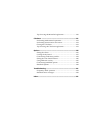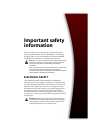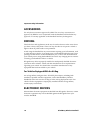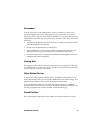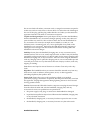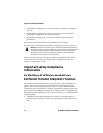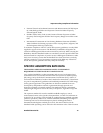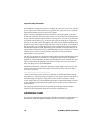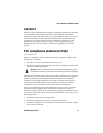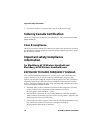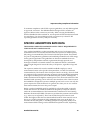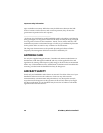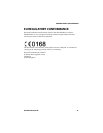Important safety/compliance information
Handheld User Guide 15
• National Council on Radiation Protection and Measurements (NCRP) Report
86, -1986, Biological Effects and Exposure Criteria for Radio Frequency
Electromagnetic Fields
• Health Canada, Safety Code 6, 1999, Limits of Human Exposure to Radio
frequency Electromagnetic Fields in the Frequency Range from 3 kHz to 300
GHz
• International Commission on Non-Ionising Radiation Protection (ICNIRP)
1998, Guidelines for limiting exposure to time-varying electric, magnetic, and
electromagnetic fields (up to 300 GHz)
To maintain compliance with FCC and IC RF exposure guidelines, use only RIM-
supplied or approved accessories. The BlackBerry handheld is designed to be
carried in a RIM-approved holster when carried on your body. When carrying the
BlackBerry Wireless Handheld while it is switched on, use the specific holster that
has been tested for compliance. If you do not use a RIM-approved holster or other
body-worn accessory, ensure that the handheld is at least 7mm from your body
when it is turned on. Use of accessories not approved by RIM may violate FCC
and IC RF exposure guidelines and may void your warranty.
SPECIFIC ABSORPTION RATE DATA
THIS MODEL WIRELESS HANDHELD MEETS GOVERNMENT
REQUIREMENTS FOR EXPOSURE TO RADIO WAVES.
Your wireless handheld is a radio transmitter and receiver. It is designed and
manufactured not to exceed the emission limits for exposure to radio frequency
(RF) energy set by the Federal Communications Commission (FCC) of the U.S.
Government and Industry Canada of the Canadian Government (IC). These limits
are part of comprehensive guidelines and establish permitted levels of RF energy
for the general population. The guidelines are based on standards that were
developed by independent scientific organizations through periodic and
thorough evaluation of scientific studies. The standards include a substantial
safety margin designed to assure the safety of all persons, regardless of age and
health.
The exposure standard for wireless mobile handhelds employs a unit of
measurement known as the Specific Absorption Rate, or SAR. The SAR limit set
by the FCC/IC is 1.6W/kg.* Tests for SAR are conducted using standard operating
positions specified by the FCC/IC with the handheld transmitting at its highest
certified power level in all tested frequency bands. Although the SAR is
determined at the highest certified power level, the actual SAR level of the
handheld while operating can be well below the maximum value. This is because



